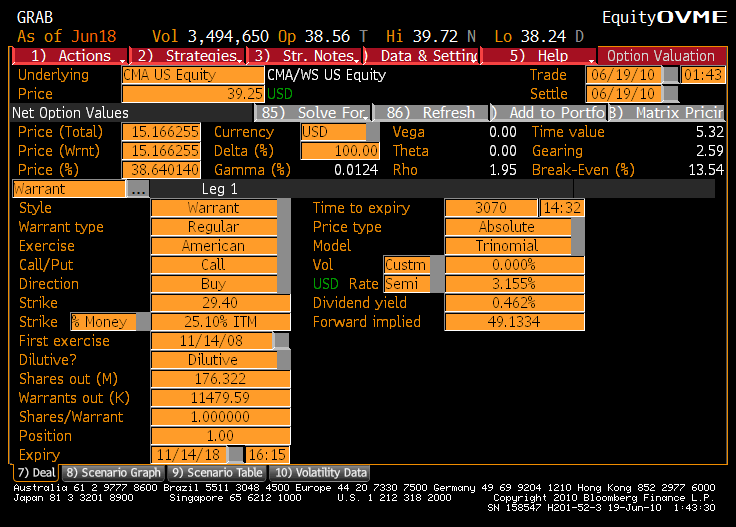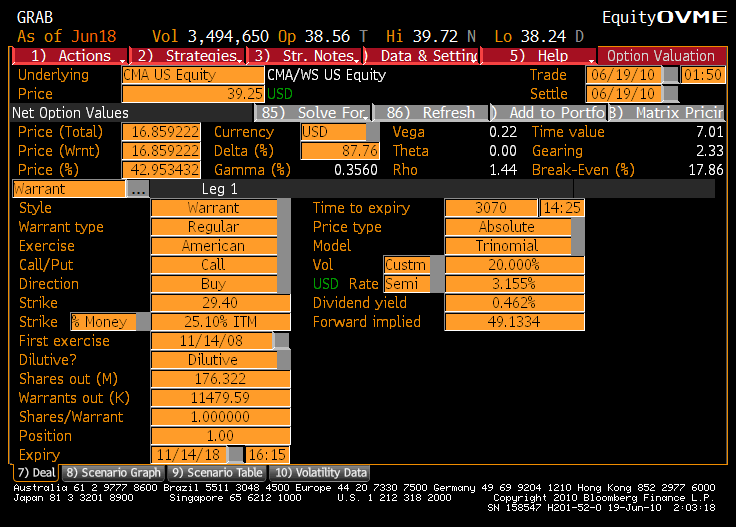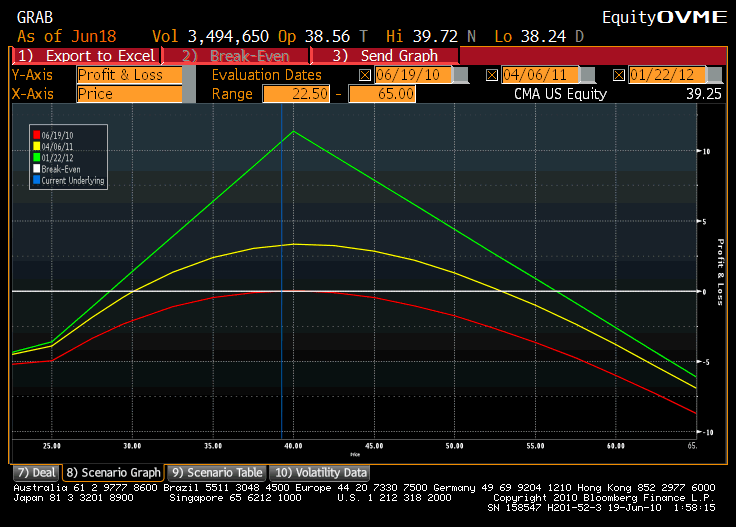This will be a bit of an unusual post for me.? How often do I suggest option trades?? Almost never.? But because of auctioning of TARP warrants, there are a decent number of very long dated options trading on some bank stocks, and many of them are cheap.? I’m here to talk about the cheapest one this evening, Comerica.
Comerica warrants [CMA/WS] closed at $14.50 today, a price that makes the computer say, “does not compute.”

The Comerica warrants are trading so cheaply that they discount negative volatility.? At zero volatility, the warrants would trade 5% higher:

And at a fair-ish volatility level, 17% higher.

Now there are two ways to extract value here.? Buy the warrant and sell short 2/3rds of a share of the common stock, which is empirically delta-neutral.

As the delta of the positions change, adjust your hedge in the common stock to reflect it.? The other way is not to short the common stock, but to short long dated options.? The most liquid long dated options are the 40s expiring in 2012.? The hedge would be to sell options on 170 shares of stock against every 100 warrants owned.
 Over ten months the transaction makes a profit with CMA stock between 30 and 53.? That is one wide band, and there is still room for adjusting hedges in ways that could improve matters.
Over ten months the transaction makes a profit with CMA stock between 30 and 53.? That is one wide band, and there is still room for adjusting hedges in ways that could improve matters.
Now, I am open to feedback from readers/bloggers who trade options.? What’s wrong with this idea?? Free money is rare in the markets, but this warrant really seems like a mispriced security.
Full disclosure: no positions
PS — note that you may not get favorable margining being long the warrant and short the option.

Zero volatility means that the price does not move at all. I am not sure how “negative volatility” would manifest itself; it seems like an impossibility. If CMA got taken out tommorrow at the closing price ($39.25 cash bid, assume no risk to deal and no possibility of a counterbid), the warrants would be worth (39.25-29.40 =) $9.85, and you would lose a considerable amount of money if you paid $14.50. The problem seems to be that you are factoring the time value of money, but there would be no reason to own this stock if volatility were in fact zero. The warrants maybe cheap, but not a no brainer or guarranteed profit.
If hedged properly, this looks like a guaranteed profit, assuming you can hold and adjust your hedge. Implied volatilities should not be negative.
Aside from the cash bid risk alluded to before, the other risk is a resumption of the dividend at the former rates, so the cost of the hedge from paying out the dividend on the short shares would rise.
David,
Let us know how much you put on for your portfolio, and please keep us informed of the trade’s progress.
I think the warrant is European exercise.
David, please explain how you would hedge this properly and make a guaranteed profit if there was a cash bid at 39.25. Please walk through the actual numbers and show a guaranteed profit. The warrants may be cheap, but you are doing something you usually preach against, relying on a model which doesn’t take into consideration all scenarios (and misreading it, in my opinion), without actually going through the cash flows. Rickl also raises a valid point, by the way.
If you are going to sell options on 1.70 shares per warrant, as you suggest in the post, model a quick cash takeover at a much higher price, say 60. total outlay = -14.5 + 10.71 (6.3*1.7) = -3.79.
Cash flow from warrant = 30.60 (60-29.4), cash flow from short calls = (60-40)*1.7=-34. Total p/l = – 3.79+30.6-34 = -7.19, a big loss.
If one uses a normalized dividend yield from the past of ~5% and plugs in an implied vol of 33%, roughly in line with listed options, the warrant prices as fair. Now one could say that if the dividend is actually restored the stock will be much higher so that there is a cheapness argument, even from a delta-neutral perspective, but only if you let your deltas run.
The model is assuming you are guaranteed the amount in the money (9.85) plus you are “saving” 3.155% on foregoing an outlay of 24.75 (39.25 minus the warrant price) for over 8 years. (and losing the current divvy for 8 years). Since this ALONE is greater than the warrant price, (simplistically 24.75 x 3.1% x 8 yrs = $6.14, it doesn’t compute. The 2 problems are 1) your rebate on the short may not be 3.1% 2) there is no adjustment for CMA divs unless over 66 cents/qtr (current 5 cents).
i haven’t looked at the details of this but:
if there is an option with a negative implied vol, that means it’s priced below intrinsic value. that means that you will make money if you go long the option and short the equity share for share. the risk is that your short becomes very expensive (ie if the borrow rate on your short goes up considerably).
if you hedge this way you won’t make (much) money if the stock goes up, but you won’t lose money either. if the stock goes down, you will make money on your short. so you are essentially long a put. if you want to monetize your position right away you can sell that put.
What is the dividend assumption you are using?
With a deeply in the money warrant, super long expiration, you are essentially getting an equity like return minus the dividends over time.
CMA dividends will presumably return to a normalized level.
To all — thanks for identifying my blind spot here.
Bloomberg has some idiosyncrasies in modeling dividends on warrants. Sometimes it forecasts a higher future dividend, sometimes it does not. in CMA’s case, it did not. If I place the future dividend rate at 4%, I get an implied vol of 31%, which is far more reasonable.
Apologies to any who took bad advice from me on this. Looking at the option market, I am guessing few tried the trade. On the bright side, there are no big losses in closing it out if you did the trade.